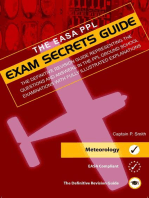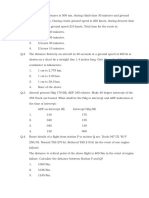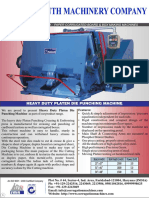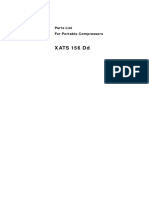Airnav CPL
Airnav CPL
Uploaded by
shombisCopyright:
Available Formats
Airnav CPL
Airnav CPL
Uploaded by
shombisOriginal Description:
Original Title
Copyright
Available Formats
Share this document
Did you find this document useful?
Is this content inappropriate?
Copyright:
Available Formats
Airnav CPL
Airnav CPL
Uploaded by
shombisCopyright:
Available Formats
CPL Air Navigation
1. Given FL 330, Temperature = -50 deg C ,RAS=310kt, what is mach numbera) 0.90
b) 0.87
c) 1.16
Ans. b
2. During a compass swing the values of coefficients are as, A=+3, B=+2 and C= -10. What will
be the expected deviation on Hdg 145 (C) in southern hemisphere
a) 120 easterly
b) 120 westerly
c) 9.30 westerly
Ans. a
3. On Mercator chart if the scale at 300N is 1:35,00,000, what will be scaled at 400 N: (Given
sin 30=0.5, cos 30=0.87, sec 30=1.15, cosec 30=2.0, cos 40=0.77, sin 40=0.64, sec 40=1.3
and cosec 40=1.5)
a) 1:2625000
b) 1:3099250
c) None of the above
Ans. c
4. An aircraft is homing to a VOR, drift 100 starboard, variation at VOR Stn is 50 W and at DR
position 3033W. Give the initial heading to maintain a radial of 274
a) 104 M
b) 084 M
c) 264 M
Ans. b
5. Aircraft present Hdg 170 (M), ADF 345 relative. Make 450 intercept of the 355 track out
bound. What shall be the Hdg to intercept and ADF indication at the time of intercept
ADF on intercept (Relative)
a) 310
b) 040
c) 045
Intercept Hdg (M)
175
135
130
Ans. c
6. If the PNR is calculated to be 880 NM with 10,000 Kg of fuel available, the distance to the
PNR with 11,000 Kg fuel available, other factors being equal, will be
a) 920 nm
b) 968 nm
c) 960 nm
Ans. b
1
CPL Air Navigation
7. The aircraft flies from position 500 N 1750 W to a new position 500 N 1750 E crossing the
international date line, the observer should
a) Decrease the date and LMT increase
b) Increase the date and LMT increases
c) Increase the date and LMT decreases
Ans. c
8. A co-located VOR/DME is being used to track on airway inbound on the 1600 radial, at 60
nm DME range, the VOR indicates 3360 on the OBS and FROM/TO reads TO, the aircraft
position is
a) VOR, CDI needle indicates one dot to the right
b) 4nm left of the airway centre line
c) 4 nm starboard of the airway centre line
Ans. c
9. The radio altimeter determines aircraft height by
a) Measuring the time interval between outgoing and incoming signals
b) Employing a pulse modulation pattern
c) Comparing the frequencies of the outgoing and the incoming signals
Ans. c
10. Listed below are factors which change density altitude
A. Decreasing barometric pressure
B. Increasing barometric pressure
C. Decreasing temperature
D. Increasing temperature
E. Decreasing relative humidity
F. Increasing relative humidity
Select the factors, which increase the density altitude at a given airport;
a) A, D & E
b) B,C & E
c) A, D & F
Ans. c
11. If a flight is made from an area of low pressure into an area of high pressure without the
altimeter setting being adjusted and a constant indicated altitude is maintained, the altimeter
would indicate
a) The actual altitude above the sea level
b) Higher than the actual altitude above sea level
c) Lower than the actual altitude above sea level
Ans. c
2
CPL Air Navigation
12. Under which of the following circumstances will GPWS not give warning about?
a) Approaching without flaps lowered
b) Approaching with the under carriage not locked down
c) Rising ground ahead
Ans. c
13. When fitted with mode C transponders, a TCAS 2 system may provide?
a) RA only
b) Horizontal plane TA & RA
c) Vertical plane TA & RA
Ans. c
14. If the pulse length used in a primary radar is 4 microseconds, ignoring receiver recovery
time, the minimum range at which a target can be detected is
a) 1200 meters
b) 2400 meters
c) 600 meters
Ans. c
15. If an aircraft with two static ports sideslips towards the blocked port, the altitude indication
will?
a) Increase
b) Decrease
c) Remain unchanged
Ans. a
16. If radar has a beam width of 3 deg and a pulse of 4 micro seconds, the target azimuth
resolution at a range of 60 nm will be approximately
a) 4 nm
b) 3 nm
c) 6 nm
Ans. b
17. What are errors in a DGI?
1. Transport wander
2. Earth rate
3. Heading errors when banking and pitching
4. Mechanical imperfection
a) 1, 2 & 4
b) 2, 3 & 4
c) All the above are correct
Ans. c
3
CPL Air Navigation
18. While using the airborne weather radar in the weather mode, the strongest returns on the
screen indicate
a) Areas of high concentration of larger water droplets
b) Areas of probable wind shear
c) Areas of severe turbulence
Ans. a
19. The operational details of an aircraft are, maximum take off weight 72,000 kg, maximum
landing weight 63,000 kg and maximum zero fuel weight 60,000 kg, burn off fuel 6.5 tons,
reserve fuel 3.5 tons, operational weight of aircraft 42,000 kg. Calculate the maximum
payload that can be carried for this flight
a) 20,000 kg
b) 18,000 kg
c) 17,500 kg
Ans. c
20. For a flight from station Z, aircraft cruises at TAS 235 kt, track out bound 090 (T), FOB
2500 lbs, normal fuel consumption 255 lbs/hr and in case of one engine failure, reduced
TAS and F/C are 180 kt TAS and 190 lbs/hr, respectively. Average wind component + 30 kt.
What shall be the radius of action if one engine fails at the time of returning back to base?
a) 1122 nm
b) 1143 nm
c) 0985 nm
Ans. a
You might also like
- Altimeter Practice Question1Document4 pagesAltimeter Practice Question1Rohit100% (1)
- PPL Exam Secrets Guide - Aviation Law & Operational ProceduresFrom EverandPPL Exam Secrets Guide - Aviation Law & Operational ProceduresRating: 4.5 out of 5 stars4.5/5 (3)
- PPL Exam Secrets Guide - Human Performance & LimitationsFrom EverandPPL Exam Secrets Guide - Human Performance & LimitationsRating: 4.5 out of 5 stars4.5/5 (3)
- ATPL Sample Questions - Radio AidsDocument5 pagesATPL Sample Questions - Radio AidsAbhinaya Sekar100% (2)
- Regulation Question BankDocument27 pagesRegulation Question BankasthNo ratings yet
- Air Navigation in IndiaDocument14 pagesAir Navigation in IndiaRamBabuMeena100% (1)
- GNAV Questions by LessonDocument83 pagesGNAV Questions by LessonLucasNo ratings yet
- 1 in 60 RuleDocument8 pages1 in 60 Rulevivek100% (1)
- Air RegulationDocument35 pagesAir RegulationsudhirvatsaNo ratings yet
- RTFQ Question Bank Entrance Test-AirlinesDocument22 pagesRTFQ Question Bank Entrance Test-AirlinesRajesh KuthrapalliNo ratings yet
- RegDocument10 pagesRegapi-3837942100% (1)
- Airregulationsquestions IndiaDocument18 pagesAirregulationsquestions IndiaachendkeNo ratings yet
- R.k.Bali 20 Q.P PDFDocument124 pagesR.k.Bali 20 Q.P PDFPrerak Kumar SharmaNo ratings yet
- Surinder Reg QBDocument44 pagesSurinder Reg QBtopgun320100% (2)
- DEparture GeneralDocument8 pagesDEparture GeneralCHANDAN KUMAR100% (1)
- HW2 - MAP PROJ CY & CADocument6 pagesHW2 - MAP PROJ CY & CAbryan7337No ratings yet
- Indigo PaperDocument5 pagesIndigo Papersummum14100% (1)
- English For Architects and Civil Engineers ILEDocument1 pageEnglish For Architects and Civil Engineers ILELaura Oviedo MatosNo ratings yet
- Flight Planning & Flight MonitoringDocument2 pagesFlight Planning & Flight MonitoringNat ChuenjumlongNo ratings yet
- Navigation 03 of FC 2022Document11 pagesNavigation 03 of FC 2022Yuvraj Singh 2》100% (2)
- Air Navigation - August 8th, 2018 QPDocument7 pagesAir Navigation - August 8th, 2018 QPsandeepjangra15100% (1)
- Regs Paper 1Document6 pagesRegs Paper 1Aditya MehtaNo ratings yet
- Air Navigation Full - 2Document10 pagesAir Navigation Full - 2Harshit dubey100% (1)
- Airnav CPLDocument4 pagesAirnav CPLRamBabuMeenaNo ratings yet
- 1 - Collected & Compiled by SQN LDR Vikram SavekarDocument31 pages1 - Collected & Compiled by SQN LDR Vikram SavekarDIP50% (2)
- General Navigation Questions PDFDocument242 pagesGeneral Navigation Questions PDFKaran Singh100% (2)
- Air Regulations 001Document116 pagesAir Regulations 001prachat100% (1)
- Regs Ques (Buti)Document24 pagesRegs Ques (Buti)Sierra Whi100% (1)
- Navigation Test Paper (156 Q.)Document33 pagesNavigation Test Paper (156 Q.)Dipanjan Choudhury60% (5)
- Buti - Regs QBDocument17 pagesButi - Regs QBtopgun320100% (2)
- Volare Questions - Mass and BalanceDocument33 pagesVolare Questions - Mass and BalanceCdr. Pearl50% (2)
- Paper 05Document21 pagesPaper 05mehul da aviatorNo ratings yet
- Cessna 172R Study QuestionsDocument2 pagesCessna 172R Study QuestionsDodgeHemi10% (1)
- RTR (A) - Questions - Consolidated PDFDocument119 pagesRTR (A) - Questions - Consolidated PDFSriram SNo ratings yet
- Albatross - Regs QBDocument47 pagesAlbatross - Regs QBtopgun320100% (1)
- CPL - Principles of FlightDocument5 pagesCPL - Principles of FlightYsl2kNo ratings yet
- Nav Test For CPL CandidatesDocument8 pagesNav Test For CPL CandidatesVivek BaskarNo ratings yet
- Regulations Chimes Question PaperDocument7 pagesRegulations Chimes Question PaperAniruddha Dalui0% (1)
- RTR Test 02Document1 pageRTR Test 02pushpak kumar Jha0% (1)
- Air Regulations Test 1 QP 20Document9 pagesAir Regulations Test 1 QP 20Abhishek DabasNo ratings yet
- Composite PPLDocument5 pagesComposite PPLsandeepjangra15100% (1)
- Metrology PDFDocument17 pagesMetrology PDFrahulNo ratings yet
- Meteorology AtplDocument27 pagesMeteorology Atpledward davisNo ratings yet
- 11 - CPL Questions Rad NavigationDocument73 pages11 - CPL Questions Rad NavigationMoshiurRahman100% (2)
- Sahil Khurana Answer KeyDocument9 pagesSahil Khurana Answer KeyAmit KhannaNo ratings yet
- Air Navigation Test No.3Document15 pagesAir Navigation Test No.3Vivek ChandraNo ratings yet
- General NavigationDocument163 pagesGeneral NavigationYahya Yıldırım95% (21)
- Regulation Miscellaneous Que. Paper - 1 Regulation Miscellaneous Que. Paper - 1Document27 pagesRegulation Miscellaneous Que. Paper - 1 Regulation Miscellaneous Que. Paper - 1prachatNo ratings yet
- Mass & Balance Questions 1Document22 pagesMass & Balance Questions 1sohan100% (1)
- Qs in Interview of RTR ADocument3 pagesQs in Interview of RTR AAishaNo ratings yet
- 050 - Meteorology (1650 Q)Document250 pages050 - Meteorology (1650 Q)obrajior100% (3)
- Revision Question Chapter 12Document12 pagesRevision Question Chapter 12Sealtiel1020No ratings yet
- Air Law Dgca 1Document26 pagesAir Law Dgca 1prachatNo ratings yet
- NavigationDocument68 pagesNavigationsakshee gojre100% (1)
- Met Question Bank PDFDocument68 pagesMet Question Bank PDFAnandhanNo ratings yet
- Dec Nav QsDocument7 pagesDec Nav QsarnavpilotNo ratings yet
- Mock Questions Expo 2 AnsDocument16 pagesMock Questions Expo 2 AnsKola IludiranNo ratings yet
- Navigation OLODE 04 2024 29th MayDocument8 pagesNavigation OLODE 04 2024 29th Maysreeramroutoneofakind443No ratings yet
- PING-2020 ADS-B Transceiver: VerviewDocument2 pagesPING-2020 ADS-B Transceiver: VerviewshombisNo ratings yet
- R4A Ais: Safety Navigation AwarenessDocument2 pagesR4A Ais: Safety Navigation AwarenessshombisNo ratings yet
- AP Guide 2015Document2 pagesAP Guide 2015shombisNo ratings yet
- Aerolite RaftDocument5 pagesAerolite RaftshombisNo ratings yet
- TX 20 DatasheetDocument1 pageTX 20 DatasheetshombisNo ratings yet
- Aviator Uav 200 Satcom BrochureDocument6 pagesAviator Uav 200 Satcom BrochureshombisNo ratings yet
- Public Notice: Government of India Technical Centre, Opp Safdarjung Airport, New DelhiDocument1 pagePublic Notice: Government of India Technical Centre, Opp Safdarjung Airport, New DelhishombisNo ratings yet
- Jus Ad BellumDocument1 pageJus Ad BellumshombisNo ratings yet
- UAS Final PDFDocument72 pagesUAS Final PDFshombisNo ratings yet
- List of Approved Dangerous Goods Training InstitutesDocument3 pagesList of Approved Dangerous Goods Training InstitutesshombisNo ratings yet
- Right To Life - The Human Rights Perspective by Anjana Nayar LLM (Nlsiu)Document13 pagesRight To Life - The Human Rights Perspective by Anjana Nayar LLM (Nlsiu)shombisNo ratings yet
- Humanity: What Is It and How Does It Influence International Law?Document22 pagesHumanity: What Is It and How Does It Influence International Law?shombis100% (1)
- Article 3Document10 pagesArticle 3shombisNo ratings yet
- Article 2Document5 pagesArticle 2shombisNo ratings yet
- Aerodrome Op MinimaDocument73 pagesAerodrome Op MinimashombisNo ratings yet
- Geneva Conventions of 1949 Additional Protocols of 1977Document2 pagesGeneva Conventions of 1949 Additional Protocols of 1977shombisNo ratings yet
- M1Ch1P1 AntiquityDocument7 pagesM1Ch1P1 AntiquityshombisNo ratings yet
- Answers Sheet (II) - MergedDocument44 pagesAnswers Sheet (II) - Mergedmarwankh305No ratings yet
- Guidelines For MbaDocument21 pagesGuidelines For MbahmanshrmNo ratings yet
- Cot 2Document5 pagesCot 2Alfredo Macadangdang Angel Jr.No ratings yet
- Benefits Education EssayDocument8 pagesBenefits Education Essaygatxsknbf100% (2)
- Die Punching Machine PDFDocument1 pageDie Punching Machine PDFAsfakvhora92100% (1)
- FICEB - Design GuideDocument42 pagesFICEB - Design GuideJaleel ClaasenNo ratings yet
- HEI P U 0543 - SelfLearning - 20210723105858Document4 pagesHEI P U 0543 - SelfLearning - 20210723105858sanjchandanNo ratings yet
- Task Analysis WeekDocument17 pagesTask Analysis WeekHaider RajputNo ratings yet
- Caso 5. (2012) - Managing Innovation Dilemmas The Cube SolutionDocument14 pagesCaso 5. (2012) - Managing Innovation Dilemmas The Cube Solutionluis chinoNo ratings yet
- English Grammar ExerciseDocument74 pagesEnglish Grammar ExerciseQuynh Nhu PhanNo ratings yet
- Budget On RaiwayDocument19 pagesBudget On RaiwayRAJ SINGHNo ratings yet
- Tiktok Challenge 5 4-3 2-1 ScoreDocument1 pageTiktok Challenge 5 4-3 2-1 ScoreVhon Joseph Solomon LptNo ratings yet
- No Objection CertificateDocument1 pageNo Objection CertificateMomin MondalNo ratings yet
- DCSS StrategicPlan 3-15-2022Document22 pagesDCSS StrategicPlan 3-15-2022Manish DubeyNo ratings yet
- C Q C III User's Manual: Ummins Uick HeckDocument34 pagesC Q C III User's Manual: Ummins Uick HecknalakaindrajithNo ratings yet
- Top 50 Management Consulting Firms Guide PDFDocument165 pagesTop 50 Management Consulting Firms Guide PDFSunny Naresh Manchanda100% (1)
- FrclobbyingreportDocument20 pagesFrclobbyingreportdaveweigelNo ratings yet
- HE 3 Questions - UpdatedDocument6 pagesHE 3 Questions - Updatedhalelz69No ratings yet
- 03 - Pathology CELL INJURY L2 Medical Sept. 2019Document34 pages03 - Pathology CELL INJURY L2 Medical Sept. 2019Saman ArshadNo ratings yet
- XATS 156 DD: Parts List For Portable CompressorsDocument132 pagesXATS 156 DD: Parts List For Portable Compressorsdavid perezNo ratings yet
- Yardstick International College Online ProgramDocument6 pagesYardstick International College Online ProgramAbelNo ratings yet
- Ultimate Preposition PracticeDocument12 pagesUltimate Preposition PracticeSanskriti Agarwal100% (1)
- A Historical Evaluation of Shipbuilding Heritage in The Bengal RegionDocument13 pagesA Historical Evaluation of Shipbuilding Heritage in The Bengal RegionmmmNo ratings yet
- DF-629 Installation Manual: 1. Accessory PartsDocument10 pagesDF-629 Installation Manual: 1. Accessory PartsANDY BNo ratings yet
- 8 PHYSIOLOGIC CHANGES IN AGING AFFECTING VARIOUS SYSTEMS 2nd PartDocument9 pages8 PHYSIOLOGIC CHANGES IN AGING AFFECTING VARIOUS SYSTEMS 2nd Partgwen manalonNo ratings yet
- 02.9.2021 - Application of Integration in Economics and Business 20.3.2021Document8 pages02.9.2021 - Application of Integration in Economics and Business 20.3.20212K19/EN/055 SHIVAM MISHRANo ratings yet
- Icici Bank: by Janagaraj Kumar - 05 (Iipm) Udaya Shankar - 09 (Isbe) Rahmanrazik - 14 (Iipm)Document20 pagesIcici Bank: by Janagaraj Kumar - 05 (Iipm) Udaya Shankar - 09 (Isbe) Rahmanrazik - 14 (Iipm)harihararajanNo ratings yet
- ASID11000159 - HMI 500 - User Manual - Configuration and Use of The Client Component (1 5 0)Document49 pagesASID11000159 - HMI 500 - User Manual - Configuration and Use of The Client Component (1 5 0)giovanny jose valencia lagosNo ratings yet
- CSC 411: Computer Network Security: Intrusion Detection SystemsDocument3 pagesCSC 411: Computer Network Security: Intrusion Detection SystemsCharles MasilaNo ratings yet










































































































